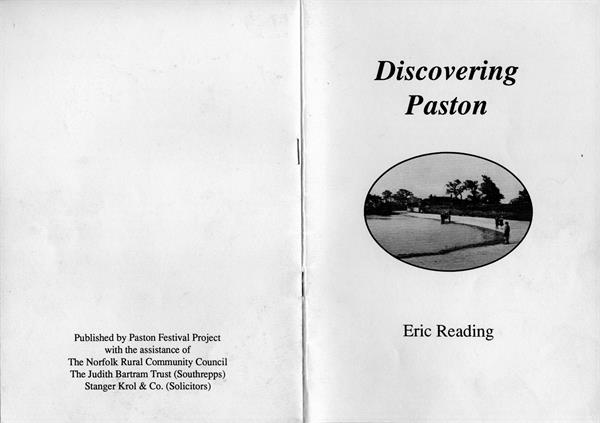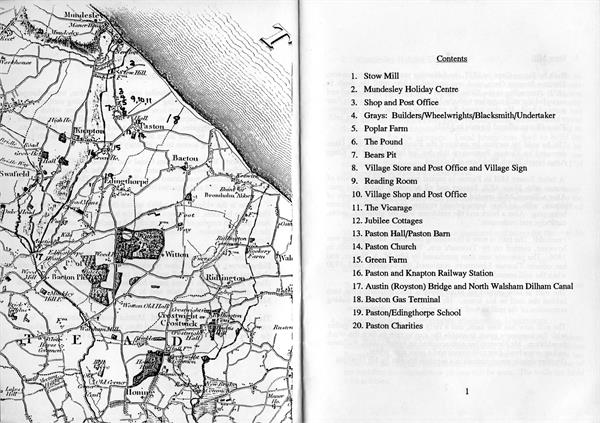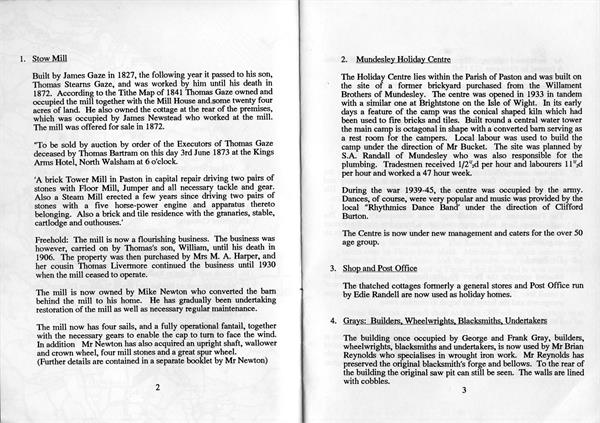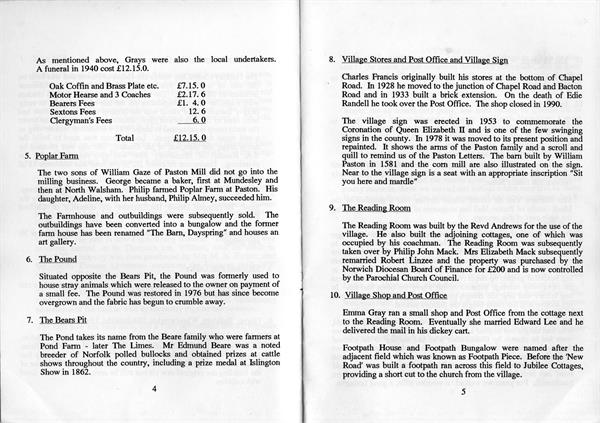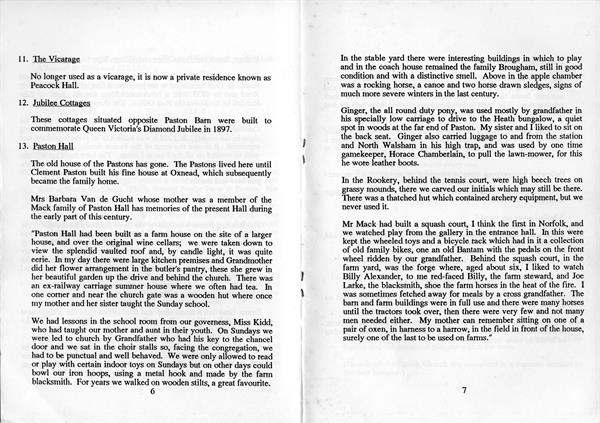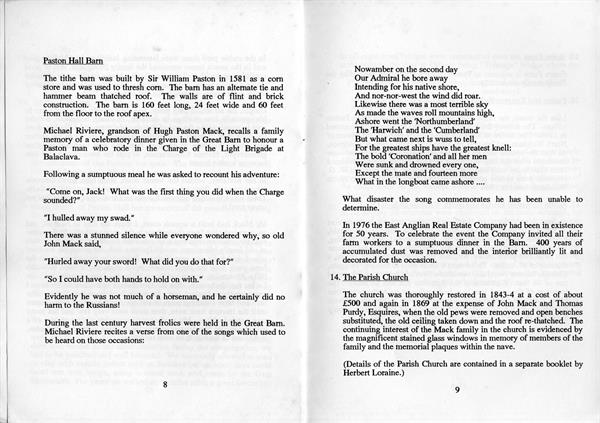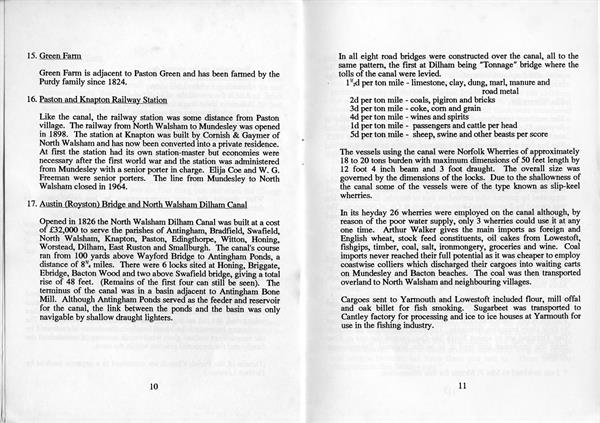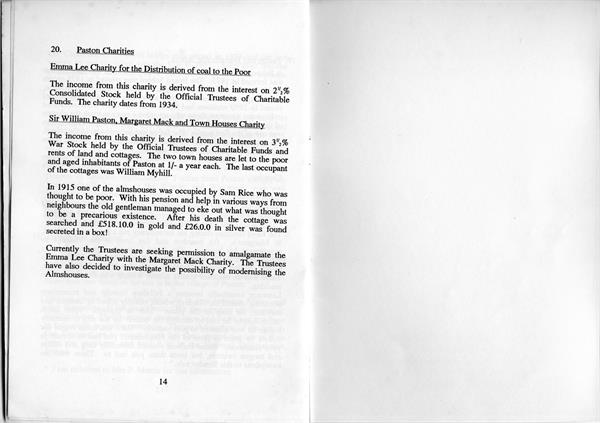Discovering Paston
Eric Reading
Published by Paston Festival Project with the assistance of
The Norfolk Rural Community Council
The Judith Bartram Trust (Southrepps)
Stanger Krol & Co. (Solicitors)
Contents
1. Stow Mill
2. Mundesley Holiday Centre
3. Shop and Post Office
4. Grays: Bunders/Wheelwrights/Blacksmith/Undertaker
5. Poplar Farm
6. The Pound
7. Bears Pit
8. Village Store and Post Office and Village Sign
9. Reading Room
10. Village Shop and Post Office
11. The Vicarage
12. Jubilee Cottages
13. Paston Hall/Paston Barn
14. Paston Church
15. Green Farm
16. Paston and Knapton Railway Station
17. Austin (Royston) Bridge and North Walsham Dilham Canal
18. Bacton Gas Terminal
19. Paston/Edingthorpe School
20. Paston Charities
Discovering Paston
Introduction
As in many villages of similar size and population, many changes have taken place within living memory. Modern farming methods have meant that very few men are now employed in agriculture, which at one time was the chief occupation. Gone are the small fields with their quaint names, Spriggates, Snapes, Toolhouse Piece, Parsons Pightle, etc. Gone too are the verdant lanes leading to the beach. Yarmouth Lane only remains giving access to the Holiday Camp.
The North Walsham Dilham Canal was opened in 1826, transporting merchandise at advantageous rates to the Staithe at Austin (Royston) Bridge. The canal was closed to traffic in 1935. The railway came to the village in 1898 and departed in 1964.
Gone is the village shop which served the village for over 60 years. Grays, the builders, has closed. When the horse reigned supreme on the farm the firm employed a blacksmith and wheelwright and also acted as the local undertaker. A second blacksmith was also employed at Hall Farm.
At one time the village boasted a Methodist Chapel, School (with Edingthorpe), Corn mill, shoe repairer, hairdresser, public house, men's club and also ran a football and bowls team. Happily the village pond (Bears Pit) which in recent times had been completely overgrown has been cleared by Mr Clabon and is now a credit to the community. Mallard, coot and swans have colonised this fine stretch of water.
The 1826 map of Paston and District overleaf shows the main configuration of road which existed then, as now, with the exception of the 'New Road', built in 1928, which extends from the village shop to Jubilee Cottages.
1. Stow Mill
Built by James Gaze in 1827, the following year it passed to his son, Thomas Stearns Gaze, and was worked by him until his death in 1872. According to the Tithe Map of 1841 Thomas Gaze owned and occupied the mill together with the Mill House and some twenty four acres of land. He also owned the cottage at the rear of the premises, which was occupied by James Newstead who worked at the mill. The mill was offered for sale in 1872.
"To be sold by auction by order of the Executors of Thomas Gaze deceased by Thomas Bartram on this day 3rd June 1873 at the Kings Anns Hotel, North Walsham at 6 o'clock.
'A brick Tower Mill in Paston in capital repair driving two pairs of stones with Floor Mill, Jumper and all necessary tackle and gear. Also a Steam Mill erected a few years since driving two pairs of stones with a five horse-power engine and apparatus thereto belonging. Also a brick and tile residence with the granaries, stable, cartlodge and outhouses.'
Freehold: The mill is now a flourishing business. The business was however, carried on by Thomas's son, William, until his death in 1906. The property was then purchased by Mrs M. A. Harper, and her cousin Thomas Livermore continued the business until 1930 when the mill ceased to operate.
The mill is now owned by Mike Newton who converted the barn behind the mill to his home. He has gradually been undertaking restoration of the mill as well as necessary regular maintenance.
The mill now has four sails, and a fully operational fantail, together with the necessary gears to enable the cap to turn to face the wind. In addition Mr Newton has also acquired an upright shaft, wallower and crown wheel, four mill stones and a great spur wheel. (Further details are contained in a separate booklet by Mr Newton)
2. Mundesley Holiday Centre
The Holiday Centre lies within the Parish of Paston and was built on the site of a former brickyard purchased from the Willament Brothers of Mundesley. The centre was opened in 1933 in tandem with a similar one at Brightstone on the Isle of Wight. In its early days a feature of the camp was the conical shaped kiln which had been used to fire bricks and tiles. Built round a central water tower the main camp is octagonal in shape with a converted barn serving as a rest room for the campers. Local labour was used to build the camp under the direction of Mr Bucket. The site was planned by S.A. Randall of Mundesley who was also responsible for the plumbing. Tradesmen received 1/2 "2d per hour and labourers 11 "2d per hour and worked a 47 hour week.
During the war 1939-45, the centre was occupied by the army. Dances, of course, were very popular and music was provided by the local "Rhythmics Dance Band' under the direction of Clifford Burton.
The Centre is now under new management and caters for the over 50 age group.
3. Shop and Post Office
The thatched cottages formerly a general stores and Post Office run by Edie Randell are now used as holiday homes.
4. Grays: Builders. Wheelwrights. Blacksmiths, Undertakers
The building once occupied by George and Frank Gray, builders, wheelwrights, blacksmiths and undertakers, is now used by Mr Brian Reynolds who specialises in wrought iron work. Mr Reynolds has preserved the original blacksmith's forge and bellows. To the rear of the building the original saw pit can still be seen. The walls are lined with cobbles.
As mentioned above, Grays were also the local undertakers. A funeral in 1940 cost £12.15.0.
Oak Coffin and Brass Plate etc. £7.15. 0
Motor Hearse and 3 Coaches £2.17. 6
Bearers Fees £1. 4. 0
Sextons Fees 12. 6
Clergyman's Fees 6. 0
Total £12.15.0
5. Poplar Farm
The two sons of William Gaze of Paston Mill did not go into the milling business. George became a baker, first at Mundesley and then at North Walsham. Philip farmed Poplar Farm at Paston. His daughter, Adeline, with her husband, Philip Almey, succeeded him.
The Farmhouse and outbuildings were subsequently sold. The outbuildings have been converted into a bungalow and the former farm house has been renamed "The Barn, Dayspring" and houses an art gallery.
6. The Pound
Situated opposite the Bears Pit, the Pound was formerly used to house stray animals which were released to the owner on payment of a small fee. The Pound was restored in 1976 but has since become overgrown and the fabric has begun to crumble away.
7. The Bears Pit
The Pond takes its name from the Beare family who were farmers at Pond Farm - later The Limes. Mr Edmund Beare was a noted breeder of Norfolk polled bullocks and obtained prizes at cattle shows throughout the country, including a prize medal at Islington Show in 1862.
8. Village Stores and Post Office and Village Sign
Charles Francis originally built his stores at the bottom of Chapel Road. In 1928 he moved to the junction of Chapel Road and Bacton Road and in 1933 built a brick extension. On the death of Edie Randell he took over the Post Office. The shop closed in 1990.
The village sign was erected in 1953 to commemorate the Coronation of Queen Elizabeth II and is one of the few swinging signs in the county. In 1978 it was moved to its present position and repainted. It shows the arms of the Paston family and a scroll and quill to remind us of the Paston Letters. The barn built by William Paston in 1581 and the corn mill are also illustrated on the sign. Near to the village sign is a seat with an appropriate inscription "Sit you here and mardle"
9. The Reading Room
The Reading Room was built by the Revd Andrews for the use of the village. He also built the adjoining cottages, one of which was occupied by his coachman. The Reading Room was subsequently taken over by Philip John Mack. Mrs Elizabeth Mack subsequently remarried Robert Linzee and the property was purchased by the Norwich Diocesan Board of Finance for £200 and is now controlled by the Parochial Church Council.
10. Village Shop and Post Office
Emma Gray ran a small shop and Post Office from the cottage next to the Reading Room. Eventually she married Edward Lee and he delivered the mail in his dickey cart.
Footpath House and Footpath Bungalow were named after the adjacent field which was known as Footpath Piece. Before the 'New Road' was built a footpath ran across this field to Jubilee Cottages, providing a short cut to the church from the village.
11. The Vicarage
No longer used as a vicarage, it is now a private residence known as Peacock Hall.
12. Jubilee Cottages
These cottages situated opposite Paston Barn were built to commemorate Queen Victoria's Diamond Jubilee in 1897.
13. Paston Hall
The old house of the Pastons has gone. The Pastons lived here until Clement Paston built his fine house at Oxnead, which subsequently became the family home.
Mrs Barbara Van de Gucht whose mother was a member of the Mack family of Paston Hall has memories of the present Hall during the early part of this century.
"Paston Hall had been built as a farm house on the site of a larger house, and over the original wine cellars; we were taken down to view the splendid vaulted roof and, by candle light, it was quite eerie. In my day there were large kitchen premises and Grandmother did her flower arrangement in the butler's pantry, these she grew in her beautiful garden up the drive and behind the church. There was an ex-railway carriage summer house where we often had tea. In one corner and near the church gate was a wooden hut where once my mother and her sister taught the Sunday school.
We had lessons in the school room from our governess, Miss Kidd, who had taught our mother and aunt in their youth. On Sundays we were led to church by Grandfather who had his key to the chancel door and we sat in the choir stalls so, facing the congregation, we had to be punctual and well behaved. We were only allowed to read or play with certain indoor toys on Sundays but on other days could bowl our iron hoops, using a metal hook and made by the farm blacksmith. For years we walked on wooden stilts, a great favourite.
In the stable yard there were interesting buildings in which to play and in the coach house remained the family Brougham, still in good condition and with a distinctive smell. Above in the apple chamber was a rocking horse, a canoe and two horse drawn sledges, signs of much more severe winters in the last century.
Ginger, the all round duty pony, was used mostly by grandfather in his specially low carriage to drive to the Heath bungalow, a quiet spot in woods at the far end of Paston. My sister and I liked to sit on the back seat. Ginger also carried luggage to and from the station and North Walsham in his high trap, and was used by one time gamekeeper, Horace Chamberlain, to pull the lawn-mower, for this he wore leather boots.
In the Rookery, behind the tennis court, were high beech trees on grassy mounds, there we carved our initials which may still be there. There was a thatched hut which contained archery equipment, but we never used it.
Mr Mack had built a squash court, I think the first in Norfolk, and we watched play from the gallery in the entrance hall. In this were kept the wheeled toys and a bicycle rack which had in it a collection of old family bikes, one an old Bantam with the pedals on the front wheel ridden by our grandfather. Behind the squash court, in the farm yard, was the forge where, aged about six, I liked to watch Billy Alexander, to me red-faced Billy, the farm steward, and Joe Larke, the blacksmith, shoe the farm horses in the heat of the fire. I was sometimes fetched away for meals by a cross grandfather. The barn and farm buildings were in full use and there were many horses until the tractors took over, then there were very few and not many men needed either. My mother can remember sitting on one of a pair of oxen, in harness to a harrow, in the field in front of the house, surely one of the last to be used on farms."
Paston Hall Barn
The tithe barn was built by Sir William Paston in 1581 as a corn store and was used to thresh corn. The barn has an alternate tie and hammer beam thatched roof. The walls are of flint and brick construction. The barn is 160 feet long, 24 feet wide and 60 feet from the floor to the roof apex.
Michael Riviere, grandson of Hugh Paston Mack, recalls a family memory of a celebratory dinner given in the Great Barn to honour a Paston man who rode in the Charge of the Light Brigade at Balaclava.
Following a sumptuous meal he was asked to recount his adventure:
"Come on, Jack! What was the first thing you did when the Charge sounded?"
"I hulled away my swad."
There was a stunned silence while everyone wondered why, so old John Mack said,
"Hurled away your sword! What did you do that for?" "So I could have both hands to hold on with."
Evidently he was not much of a horseman, and he certainly did no harm to the Russians!
During the last century harvest frolics were held in the Great Barn. Michael Riviere recites a verse from one of the songs which used to be heard on those occasions:
Nowamber on the second day
Our Admiral he bore away
Intending for his native shore,
And nor-nor-west the wind did roar.
Likewise there was a most terrible sky
As made the waves roll mountains high,
Ashore went the 'Northumberland'
The 'Harwich' and the 'Cumberland'
But what came next is wuss to tell,
For the greatest ships have the greatest knell:
The bold 'Coronation' and all her men
Were sunk and drowned every one,
Except the mate and fourteen more
What in the longboat came ashore ....
What disaster the song commemorates he has been unable to determine.
In 1976 the East Anglian Real Estate Company had been in existence for 50 years. To celebrate the event the Company invited all their farm workers to a sumptuous dinner in the Barn. 400 years of accumulated dust was removed and the interior brilliantly lit and decorated for the occasion.
14. The Parish Church
The church was thoroughly restored in 1843-4 at a cost of about £500 and again in 1869 at the expense of John Mack and Thomas Purdy, Esquires, when the old pews were removed and open benches substituted, the old ceiling taken down and the roof re-thatched. The continuing interest of the Mack family in the church is evidenced by the magnificent stained glass windows in memory of members of the family and the memorial plaques within the nave.
(Details of the Parish Church are contained in a separate booklet by Herbert Loraine.)
15. Green Farm
Green Farm is adjacent to Paston Green and has been farmed by the Purdy family since 1824.
16. Paston and Knapton Railway Station
Like the canal, the railway station was some distance from Paston village. The railway from North Walsham to Mundesley was opened in 1898. The station at Knapton was built by Cornish & Gaymer of North Walsham and has now been converted into a private residence. At first the station had its own station-master but economies were necessary after the first world war and the station was administered from Mundesley with a senior porter in charge. Elija Coe and W. G. Freeman were senior porters. The line from Mundesley to North Walsham closed in 1964.
17. Austin (Royston) Bridge and North Walsham Dilham Canal
Opened in 1826 the North Walsham Dilham Canal was built at a cost of £32,000 to serve the parishes of Antingham, Bradfield, Swafield, North Walsham, Knapton, Paston, Edingthorpe, Witton, Honing, Worstead, Dilham, East Ruston and Smallburgh. The canal's course ran from 100 yards above Way ford Bridge to Antingham Ponds, a distance of S miles. There were 6 locks sited at Honing, Briggate, Ebridge, Bacton Wood and two above Swafield bridge, giving a total rise of 48 feet. (Remains of the first four can still be seen). The terminus of the canal was in a basin adjacent to Antingham Bone Mill. Although Antingham Ponds served as the feeder and reservoir for the canal, the link between the ponds and the basin was only navigable by shallow draught lighters.
In all eight road bridges were constructed over the canal, all to the same pattern, the first at Dilham being "Tonnage" bridge where the tolls of the canal were levied. 1 "2d per ton mile - limestone, clay, dung, marl, manure and
road metal
2d per ton mile - coals, pigiron and bricks
3d per ton mile - coke, corn and grain
4d per ton mile - wines and spirits
Id per ton mile - passengers and cattle per head
5d per ton mile - sheep, swine and other beasts per score
The vessels using the canal were Norfolk Wherries of approximately 18 to 20 tons burden with maximum dimensions of 50 feet length by 12 foot 4 inch beam and 3 foot draught. The overall size was governed by the dimensions of the locks. Due to the shallowness of the canal some of the vessels were of the type known as slip-keel wherries.
In its heyday 26 wherries were employed on the canal although, by reason of the poor water supply, only 3 wherries could use it at any one time. Arthur Walker gives the main imports as foreign and English wheat, stock feed constituents, oil cakes from Lowestoft, fishgips, timber, coal, salt, ironmongery, groceries and wine. Coal imports never reached their full potential as it was cheaper to employ coastwise colliers which discharged their cargoes into waiting carts on Mundesley and Bacton beaches. The coal was then transported overland to North Walsham and neighbouring villages.
Cargoes sent to Yarmouth and Lowestoft included flour, mill offal and oak billet for fish smoking. Sugarbeet was transported to Cantley factory for processing and ice to ice houses at Yarmouth for use in the fishing industry.
The Canal above Swafield bridge was closed in 1893 and the last wherry to use the canal was the Ella in 1935. Soon after this the canal silted up and currently is only navigable as far as Tonnage bridge.
The Wherry Inn
The southern boundary of the parish impinges upon the canal at Royston (Austin) Bridge and it was here beside the hump-backed road bridge that the combined Inn and granary was built in 1825. The Inn had a staithe wharf and granary dealing in local grain and lime. Local farmers brought their water carts to the staithe which provided water for their stock.
Despite its situation approximately 3 miles from Paston village, the Inn, originally known as the Wherry and Waterman, was well supported by patrons who arrived on foot or bicycle. Latterly the Inn was owned by Steward and Patterson Finch & Co. of Norwich. The Inn sign was a wherry in full sail. The last publicans before it closed in 1965 were George and Ellen Hipperson.
18. Bacton Gas Terminal
* The Bacton Gas Terminal, which covers approximately one hundred and eighty six acres, was built during the period October 1967 to June 1968. It is one of Britain's principal natural gas terminals. More than two thirds of the site is in the village of Paston.
The gas comes from fields which he in area between fifteen and sixty five miles off the East Coast. The three groups of companies, Phillips/Arpet, Shell/Esso and Amaco have laid under sea pipelines to their shore reception terminals. The main functions of the British Gas Terminal are to accept North Sea Gas, control the rate of flow from the producers and feed it in to the National Transmission System.
(* I am indebted to Mrs P. Morris for this information.)
19. Paston and Edingthorpe School
A School Board for the united Parishes of Paston and Edingthorpe was formed in 1875. The Board School was erected in 1878 on the parish boundary of the two villages. Intended to house 100 children, the average attendance was never more than 70. When the school closed in 1959 numbers had fallen to 22 and these were transferred to Bacton. Amongst those who attended a party to mark the closure of the school was Mrs Alice Pardon of Pond Cottage, Paston, who was one of the first pupils. Her father had helped to build the school. She recalled that she had received her schooling in a cottage in the village before the Board School was built.
The school is now a private residence. Fortunately the Honours Board has been preserved and now hangs in Edingthorpe Parish Church.
Other Schools
During last century Elizabeth Gray, daughter of Thomas Gaze of Paston Mill ran a Dame School after the death of her husband. Children who attended received their education for 2d a week. The Revd Eastman during his incumbency ran a Preparatory School, St Margaret's, for boarders and day boys at the Vicarage to supplement his income. The Revd Laurence Inge attended this school in 1917. His father was the local chemist at Mundesley. He recalls cycling to school each day, together with other day boys. There was an assistant master named Weston who did most of the teaching.
Laurence eventually became a full-time boarder and remembers attending church on Sundays where, suitably robed in 'cassock and surplice', he sang in the choir. This he enjoyed. After lunch unfortunately he had to commit the collect for the day to memory before he was allowed to play outside. "Until you could repeat the collect by heart in front of the Headmaster, you had to remain in your classroom. Some collects seemed incredibly long and others real tongue twisters, but learn them you had to. There were no exceptions to this Sunday rule."
20. Paston Charities
Emma Lee Charity for the Distribution of coal to the Poor
The income from this charity is derived from the interest on 2"2% Consolidated Stock held by the Official Trustees of Charitable Funds. The charity dates from 1934.
Sir William Paston. Margaret Mack and Town Houses Charity
The income from this charity is derived from the interest on 3"2% War Stock held by the Official Trustees of Charitable Funds and rents of land and cottages. The two town houses are let to the poor and aged inhabitants of Paston at 1/- a year each. The last occupant of the cottages was William My hill.
In 1915 one of the almshouses was occupied by Sam Rice who was thought to be poor. With his pension and help in various ways from neighbours the old gentleman managed to eke out what was thought to be a precarious existence. After his death the cottage was searched and £518.10.0 in gold and £26.0.0 in silver was found secreted in a box!
Currently the Trustees are seeking permission to amalgamate the Emma Lee Charity with the Margaret Mack Charity. The Trustees have also decided to investigate the possibility of modernising the Almshouses.
